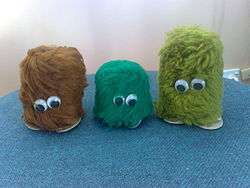Gonk

Gonks are a novelty toy originating from the United Kingdom in the 1960s. Initially created by English inventor Robert Benson as an informal project, the toys went on to gain worldwide popularity due to a combination of their kitsch style and public endorsement by celebrities such as Ringo Starr and Peter Sellers. Gonks' signature features include a small, spherical body, a furry texture, and two googly eyes. Now with collectible status[1], their legacy is one of being the first toy crazes of the post-war period.
History
When Londoner Robert Benson invented the original toys, the project was something of a joke. The novelty items, often with comical eyes, arms, and legs that went with outlandish outfits, achieved much popularity in the United Kingdom in the 1960s.[2][1] The toy's deliberately kitsch appearance attracted attention, with some having strident outfits such as Merseybeat rockers, and the gonks were marketed as collectibles. Soon, the toys got shipped as far away as nations such as Canada and the United States. Receiving praise from contemporary articles in publications such as the Evening Times and Newsweek,[1][3] some of the more whimsical looking dolls attracted comparisons in the U.S. to the op art movement.[4]
The company GUND began to sell Gonks at a large scale in the U.S., including inflatable vinyl versions.[3][5] The toys had a reputation for being quirky looking,[1] and homemade toy gonks were made by groups such as U.S. Girl Scout troops.[6]
They were featured in the film title design of the 1965 science fiction film Gonks Go Beat, a movie created by the exploitation film impresario Robert Hartford-Davis that featured a Romeo and Juilet-like love story mixed in with many celebrity appearances by music figures such as Ginger Baker and Lulu. The movie has gained infamy over the years as one of the worst British films of all time.[7]
They lost the Toy Retailers Association's 'Toy of the Year' title to the 'Action Man' dolls. Later crazes include the late-1990s Furby wave and the mid-2000s RoboSapien.[2] In retrospect, years after their popularity peak, some commentators such as film critic Graeme Clark have labeled gonks as "dated and goofy".[7] However, authors Gladys Greenaway and Kathryn Greenaway have remarked, "Little children love them", and the two wrote in the 1970s in praise of how gonks "can be made from almost any material and of any size."[8]
See also
References
- 1 2 3 4 Macdonald, Iain (May 12, 1964). "Just a Crazy Mixed up Gonk". Evening Times. Glasgow. p. 12. Retrieved September 5, 2015.
- 1 2 "Cheaper toys 'are Christmas hits'". BBC News. 28 October 2009. Retrieved 5 September 2015.
- 1 2 "Going, Going, Gonk". Newsweek. pp. 106, 109. Retrieved March 31, 2013.
- ↑ "'Living Dolls for Christmas". The Beaver County Times. Penn. November 25, 1965. p. B-9. Retrieved September 5, 2015.
- ↑ Raiffe, Bruce S.; Alex Baron Raiffe (2005). Gund. Images of America. Charleston, SC: Arcadia Publishing. p. 103. ISBN 9780738537108. OCLC 62380934. Retrieved March 31, 2013.
- ↑ "Girl Scouts Work on Decorations for University Women's Christmas Party". Lawrence Journal-World. Kansas. December 6, 1966. p. 7. Retrieved March 31, 2013.
- 1 2 Clark, Graeme. "Gonks Go Beat". thespinningimage.co.uk. Retrieved 5 September 2015. External link in
|publisher=(help) - ↑ Gladys Greenaway; Kathryn Greenaway (1973). Toy Making. Drake Publishers. p. 30.
External links

- IMDB, Gonks Go Beat (1965)